A Predator-Prey Model in the Chemostat with Time Delay
Abstract
The aim of this paper is to study the dynamics of predator-prey interaction in a chemostat to determine whether including a discrete delay to model the time between the capture of the prey and its conversion to viable biomass can introduce oscillatory dynamics even though there is a globally asymptotically stable equilibrium when the delay is ignored. Hence, Holling type I response functions are chosen so that no oscillatory behavior is possible when there is no delay. It is proven that unlike the analogous model for competition, as the parameter modeling the delay is increased, Hopf bifurcations can occur.
1. Introduction
The chemostat, also known as a continuous stir tank reactor (CSTR) in the engineering literature, is a basic piece of laboratory apparatus used for the continuous culture of microorganisms. It has potential applications for such processes as wastewater decomposition and water purification. Some ecologists consider it a lake in a laboratory. It can be thought of as three vessels, the feed bottle that contains fresh medium with all the necessary nutrients, the growth chamber where the microorganisms interact, and the collection vessel. The fresh medium from the feed bottle is continuously added to the growth chamber. The growth chamber is well stirred and its contents are then removed to the collection vessel at a rate that maintains constant volume. For a detailed description of the importance of the chemostat and its application in biology and ecology, one can refer to [1, 2].
The following system describes a food chain in the chemostat where a predator population feeds on a prey population of microorganisms that in turn consumes a nonreproducing nutrient that is assumed to be growth limiting at low concentrations
Butler et al. [3] considered the coexistence of two competing predators feeding on a single prey population growing in the chemostat. As a subsystem of their model, they studied the global stability of system (1.1) with both f(s) and g(x) taking the form of Holling type II. They proved that under certain conditions the interior equilibrium is globally asymptotically stable with respect to the interior of the positive cone. However, they also proved that for certain ranges of the parameters there is at least one nontrivial limit cycle and conjectured that the limit cycle is unique and would be a global attractor with respect to the noncritical orbits in the open positive octant. This conjecture was partially solved by Kuang [4]. He showed that there is a range of parameters for which a unique periodic orbit exists and roughly located the position of the limit cycle.
Bulter and Wolkowicz [5] studied predator mediated coexistence in the chemostat assuming D0 = D = Δ. Model (1.1) was studied as a submodel. For general monotone response functions, Bulter and Wolkowicz showed that (1.1) is uniformly persistent if the sum of the break even concentrations of substrate and prey is less than the input rate of the nutrient s0. However they showed that it is necessary to specify the form of the response functions in order to discuss the global dynamics of the model. If f(s) is modelled by Holling type I or II and g(x) by Holling type I, Bulter and Wolkowicz proved that (1.1) could have up to three equilibrium points and that there is a transfer of global stability from one equilibrium point to another as different parameters are varied making conditions favorable enough for a new population to survive. In this case, there are no periodic solutions. However, even if f(s) is given by Holling type I, if g(x) is given by Holling type II, they showed that a Hopf bifurcation can occur in (1.1), and numerical simulations indicated that the bifurcating periodic solution was asymptotically stable.
We include a time delay in (1.1) to model the time between the capture of the prey and its conversion to viable biomass. Our aim is to show that such a delay can induce nontrivial periodic solutions in a model where there is always a globally asymptotically stable equilibrium when delay is ignored, and hence no such periodic solutions are possible otherwise. For this reason we select the response functions of the simplest form; that is, we choose the Holling type I form for both f(s) and g(x), so that (1.2) always has a globally asymptotically stable equilibrium when the conversion process is assumed to occur instantaneously. It is interesting to note that in the analogous model of competition between two species in the chemostat, delay cannot induce oscillatory behavior for any reasonable monotone response functions (see Wolkowicz and Xia [6]).
With delay modelling the time required for the predator to process the prey after it has been captured, the model is given by
We analyze the stability of each equilibrium and prove that the coexistence equilibrium can undergo Hopf bifurcations. Numerical simulations appear to show that (1.2) can have a stable periodic solution bifurcating from the coexistence equilibrium as the delay parameter increases from zero. This periodic orbit can then disappear through a secondary Hopf bifurcation as the delay parameter increases further.
2. Scaling of the Model and Existence of Solutions
Suppose that functions f(s) and g(s) are of Holling type I form, that is, f(s) = αs (α > 0) and g(x) = kx (k > 0). System (1.2) reduces to
Let τ = 0. Model (2.3) reduces to a special case of the model considered in [7]. If D > α, the model has only one equilibrium point (1,0, 0) and it is globally asymptotically stable. If D < α and 1 − D/α − ΔD/k < 0, the model has a second equilibrium point (D/α, (α − D)/αD, 0) and it is globally asymptotically stable. When 1 − D/α − ΔD/k > 0, the model has a third equilibrium point (k/(k + αΔ), Δ/k, α/(k + αD) − D/k) and it is the global attractor. Therefore, model (2.3) has no periodic solutions when the time delay is ignored. If g(x) is of Holling type II form, Butler and Wolkowicz [5] proved that a Hopf bifurcation is possible resulting in a periodic solution for a certain range of parameter values. We emphasize again here, that it is for this reason that in this paper we restrict our attention to the simplest case for both response functions, that is, Holling type I, in order to see whether delay can be responsible for periodic solutions in (1.2).
Theorem 2.1. Assuming , then there exists a unique solution (s(t), x(t), y(t)) of (2.3) passing through (s0, ϕ(θ), ψ(θ)) with s(t) > 0, x(t) > 0 and y(t) > 0 for t ∈ [0, ∞). The solution is bounded. In particular, given any ϵ0 > 0, x(t) < 1 + ϵ0 for all sufficiently large t.
Proof. For t ∈ [0, τ], one has t − τ ∈ [−τ, 0], x(t − τ) = ϕ(t − τ), and y(t − τ) = ψ(t − τ). System (2.3) becomes
Now we prove s(t) > 0 for all t > 0. From the first equation of (2.3),
To prove x(t) > 0 for t ∈ [0, ∞), assume there is a first such that , and x(t) > 0 for . Divide both sides of the second equation of (2.3) by x(t) and integrate from 0 to , to obtain
To show that y(t) is positive on [0, ∞), suppose that there exists t⋆ > 0 such that y(t⋆) = 0, and y(t) > 0 for t ∈ [0, t*). Then From the third equation of (2.3), we have
To prove the boundedness of solutions, define
3. Equilibria and Stability
Model (2.3) has three equilibrium points: E1 = (1,0, 0), E2 = (D/α, (α − D)/αD, 0), and
The linearization of (2.3) about an equilibrium (s, x, y) is given by
Theorem 3.1. Equilibrium E1 is stable if α < D and unstable if α > D.
Proof. Evaluating the characteristic equation at E1 gives
Remark 3.2. If α < D, then there is only one equilibrium, E1. If α > D, equilibrium E2 also exists.
Lemma 3.3. Assume α > D. The characteristic equation evaluated at E2 has two negative eigenvalues, and the remaining eigenvalues are solutions of
Proof. Assume α > D. Equilibrium E2 exists. Consider the characteristic equation at E2. Since (α − D)/αD = (1 − s)/αs at E2,
Assuming that λ = 0 is a root of (3.8), we have
Theorem 3.4. Assume that D⩾1, Δ⩾1, k > 0, α > 0, and (k/Δ)(1/D − 1/α)⩾1 so that τc⩾0. Equilibrium E2 is locally asymptotically stable if τ > τc and unstable if τ < τc. If D = 1, then equilibrium E2 is globally asymptotically stable for τ > (1/Δ)ln (k/Δ).
Proof. Assume that τ > τc. Assumptions k > 0, Δ⩾1, and (k/Δ)(1/D − 1/α)⩾1 imply 1/D > 1/α, or equivalently α > D. By Lemma 3.3, to prove that equilibrium E2 is locally asymptotically stable, one only needs to show that (3.8) admits no root with nonnegative real part.
Consider the real roots of (3.8) first. Note that 1/D > 1/α. Equation (3.8) has no solution for λ ⩽ −Δ. Otherwise the left-hand side would be less than zero, but the right-hand side would be greater than zero. Assume λ > −Δ. The left-hand side of (3.8) is a monotone increasing function in both λ and τ, takes value 0 at λ = −Δ, and goes to positive infinity as λ → +∞ or τ → +∞. By Lemma 3.3, when τ = τc, then λ = 0 is a solution of (3.8). Thus for τ > τc, any real root λ of (3.8) must satisfy −Δ < λ < 0.
For any , we have and . Therefore there exists at least one such that is a solution of (3.8). Equilibrium E2 is unstable if τ < τc.
In what follows, we prove that if τ > τc all complex eigenvalues of (3.8) have negative real parts. Suppose that λ + Δ = γ + iβ (β > 0) is a solution of (3.8). Using the Euler formula, we have
Assume that D = 1. Now we prove that E2 is globally asymptotically stable when τ > (1/Δ)ln (k/Δ), or equivalently ke−Δτ < Δ. In this case, choose ϵ0 > 0 small enough such that ke−Δτ(1 + ϵ0) < Δ. By Theorem 2.1, for such ϵ0, there exists a T > 0 so that 0 < x(t) < 1 + ϵ0 for t > T. Hence, for t > T + τ, ke−Δτx(t − τ) < Δ. In Example 5.1 of Kuang ([10, page 32]), choose ρ(t) = τ, a(t) = Δ, b(t) = ke−Δτx(t − τ), and α = Δ/2. We obtain . Therefore y(t) → 0 as t → ∞. Let z(t) = s(t) + x(t). Noting D = 1, from (2.3), we have . Multiply by the integrating factor et, . Integrating both sides from 0 to t gives
We show that lim t→∞s(t) = 1/α and lim t→∞x(t) = (α − 1)/α. First assume that the limits exist, that is, and . From (2.3), we know that and are uniformly continuous since s(t), x(t), and y(t) are bounded. By Theorem A.3, it follows that and . Note that lim t→∞y(t) = 0. Letting t → ∞ in (2.3) gives
Now suppose that the limits do not exist. In particular if x(t) does not converge, then let and . By Lemma A.2 in the appendix, there exists {tm}↑∞ and {sm}↑∞ such that
Since s(t) + x(t) converges and x(t) converges, then s(t) must also converge. Hence lim t→∞s(t) = 1/α and lim t→∞x(t) = (α − 1)/α. It follows that E2 is globally asymptotically stable.
4. Hopf Bifurcations at E+ Assuming D = Δ = 1
Now consider the stability of E+. The characteristic equation at E+ is
Lemma 4.1. Assuming k > 0, α > 0, and k(1 − 1/α)⩾1 so that τc = ln (k(1 − 1/α))⩾0, then E+ has no zero eigenvalue for τ ∈ (0, τc).
Proof. Assume that τ ∈ (0, τc). By the method of contradiction, suppose that there exists a zero root of (4.4). Therefore
Lemma 4.2. Assume k > 0, α > 0, k(1 − 1/α) > 1. Equilibrium E+ is asymptotically stable when τ = 0.
Proof. For τ = 0, (4.4) reduces to
Lemma 4.3. As τ is increased from 0, a root of (4.4) with positive real part can only appear if a root with negative real part crosses the imaginary axis.
Proof. Taking n = 2 and g(λ, τ) = p(τ)λ + (qλ + c(τ))e−λτ + β(τ) in Kuang [10, Theorem 1.4, page 66] gives
For τ ≠ 0, assuming λ = iω (ω > 0) is a root of ,
Define conditions (H1) and (H2) as follows:
Lemma 4.4. If (H1) holds for all τ in some interval I, then (4.14) has two positive roots ω1(τ)⩾ω2(τ) for all τ ∈ I with ω1(τ) > ω2(τ) when all the inequalities in (H1) are strict. If (H2) holds for all τ in some interval I, then (4.14) has only one positive root, ω1(τ) for all τ ∈ I. If no interval exists where either (H1) or (H2) holds, then there are no positive real roots of (4.14).
Define the interval
From D = Δ = 1,
Theorem 4.5. Assume and , then I1 is not empty, and for any τ ∈ I1, but , condition (H1) holds and ω1(τ) > ω2(τ) > 0. If , then ω1(τ) > ω2(τ) = 0.
Proof. For any , we have , and therefore
In what follows, we intend to show that for any such τ, condition (H1) holds. From (4.3),
If , we have . Noting (4.25), we obtain
Now we define interval I2 and prove that (H2) holds on I2
Theorem 4.6. Assume α > 1 and . Interval I2 given by (4.41) is not empty. For any τ ∈ I2, (H2) holds and hence ω1(τ) > 0.
Proof. Assume α > 1. Letting
In what follows, we intend to show for any τ ∈ I2, or equivalently , (H2) holds. For any , by (4.44), it follows that s+(τ) > 1/α and so αs+(τ) > 1. Hence,
Condition (H2) holds. By Lemma 4.4, ω1(τ) > 0.
Next, to determine whether (4.2) has a pair of pure imaginary eigenvalues, we consider
If there exists (τ, ω) satisfying (4.52), then (4.2) has a pair of pure imaginary roots ±iω. A necessary condition for (4.52) to have solutions is . Otherwise, , and the second equation of (4.52) becomes cos (ωτ) = αs+(τ). However, for any τ ∈ (0, τc), we have αs+(τ) > 1, since
Lemma 4.7. Assume and . For any τ ∈ I1 given by (4.19), there exists ϵj > 0 and θj(τ) with ϵj ⩽ θj(τ) ⩽ π (j=1,2) such that
Proof. For any τ ∈ I1, by Theorem 4.5, ω1(τ) > 0 and ω2(τ)⩾0. It is easy to see that h1(0, τ) = 0 and lim ω→+∞h1(ω, τ) = −∞. There are two roots of h1(z, τ) = 0, z1 = 0 and
Lemma 4.8. Assume α > 1 and . For any τ ∈ I2 given by (4.41), there exists ϵ > 0 and θ1(τ) such that ϵ ⩽ θ1(τ) < π and θ1(τ) satisfies (4.56) for j = 1.
Proof. For any τ ∈ I2, by Theorem 4.6, only ω1(τ) > 0.
As in Lemma 4.7, we have h1(ω, τ) > 0 for 0 < ω < z2(τ). For any τ ∈ I2, as shown in Theorem 4.6, . Letting
Theorem 4.9. Consider system (2.3) with D = Δ = 1.
- (1)
Suppose , , and τ ∈ I1 given by (4.22). For τ ∈ I1 and j = 1,2, ωj(τ) is nonnegative and there exists ϵj > 0 and θj(τ) such that ϵj ⩽ θj(τ) ⩽ π and θj(τ) satisfies (4.56). If there exists n⩾0 such that θj(τ) + 2nπ intersects τωj(τ) at some , then (4.4) has a pair of pure imaginary eigenvalues . System (2.3) undergoes a Hopf bifurcation at provided .
- (2)
Suppose α > 1, , and τ ∈ I2 given by (4.41). For τ ∈ I2, only ω1(τ) is positive and there exists ϵ > 0 and θ1(τ) such that ϵ ⩽ θ1(τ) < π and θ1(τ) satisfies (4.56) for j = 1. If there exists n⩾0 such that θ1(τ) + 2nπ intersects τω1(τ) at some , then (4.4) has a pair of pure imaginary eigenvalues . System (2.3) undergoes a Hopf bifurcation at provided .
Proof. Assume D = Δ = 1 in system (2.3).
Case 1. Suppose τ ∈ I1. By Theorem 4.5, ωj(τ)⩾0 for j = 1,2. By Lemma 4.7, there exists ϵj > 0 and θj(τ) such that ϵj ⩽ θj(τ) ⩽ π and θj(τ) satisfies (4.56). Assume that there exists a positive integer such that for some integer n⩾0. Then system (4.52) has one solution . Equation (4.4) has a pair of pure imaginary eigenvalues .
In what follows, we show that the conditions required for a Hopf Bifurcation (see Theorem A.1 in the appendix) are satisfied by the linearization (3.3) of (2.3) at E+. In (A.1), choosing τ as the bifurcation parameter and letting
The characteristic equation (4.4) of (3.3) at E+ has a pair of pure imaginary eigenvalues and no other root of (4.4) is an integral multiple of . Hence the hypothesis (S2) in the Hopf Bifurcation Theorem holds. Therefore, (2.3) undergoes a Hopf bifurcation at E+ when provided .
Case 2. Suppose τ ∈ I2. By Theorem 4.5, only ω1(τ) > 0. By Lemma 4.8, there exists ϵ > 0 and θ1(τ) such that ϵ ⩽ θ1(τ) < π and θ1(τ) satisfies (4.56). Assume there exists such that for some integer n⩾0. Then system (4.52) has one solution . Equation (4.4) has a pair of pure imaginary eigenvalues . The rest of the proof is similar to that of Case 1 when j = 1.
Corollary 4.10. Consider system (2.3) with D = Δ = 1.
- (1)
Suppose , , and τ ∈ I1 given by (4.22). For τ ∈ I1, ωj(τ) is nonnegative and there exists ϵj > 0 and θj(τ) such that ϵj ⩽ θj(τ) ⩽ π and θj(τ) satisfies (4.56) for j = 1,2. If there exists a positive integer nj⩾0 such that and , then θj(τ) + 2njπ intersects τωj(τ) at least once at some . System (2.3) undergoes a Hopf bifurcation at provided .
- (2)
Suppose α > 1, , and τ ∈ I2 defined in (4.41). For τ ∈ I2, only ω1(τ) is positive. There exists ϵ > 0 and θ1(τ) such that ϵ ⩽ θ1(τ) < π and θ1(τ) satisfies (4.56) for j = 1. If there exists a positive integer N⩾0 such that , then for any 0 ⩽ n ⩽ N, θ1(τ) + 2nπ intersects τω1(τ) at least once at some . System (2.3) undergoes a Hopf bifurcation at provided .
Proof. Assume D = Δ = 1 in system (2.3).
Case 1. Suppose τ ∈ I1. By Theorem 4.5, ωj(τ)⩾0 for j = 1,2. By Lemma 4.7, there exists ϵj > 0 and θj(τ) such that ϵj ⩽ θj(τ) ⩽ π and θj(τ) satisfies (4.56). Assume that there exists a positive integer nj⩾0 such that and . For such nj,
Case 2. Suppose τ ∈ I2. By Theorem 4.5, only ω1(τ) > 0. By Lemma 4.8, there exists ϵ > 0 and θ1(τ) such that ϵ ⩽ θ1(τ) < π and θ1(τ) satisfies (4.56). Assume that there exists a positive integer N⩾0 such that . By (4.41), 0 ∈ I2. Therefore . For 0 ⩽ n ⩽ N,
Corollary 4.11. Consider system (2.3) with D = Δ = 1. Assume and . If , then , where I1 was defined in (4.22). For any τ ∈ I1, ωj(τ) is nonnegative and there exists ϵj > 0 and θj(τ) such that ϵj ⩽ θj(τ) ⩽ π and θj(τ) satisfies (4.56) for j = 1,2. If there exists a positive integer Nj⩾0 (j = 1,2) such that , then for any 0 ⩽ n ⩽ Nj, θj(τ) + 2nπ intersects τωj(τ) at least once at some . System (2.3) undergoes a Hopf bifurcation at provided .
Proof. Assume . Then By (4.22),
5. Numerical Results
This section includes bifurcation diagrams involving the interior equilibrium E+ and numerical simulations of periodic solutions of the predator-prey model in the chemostat.
5.1. Variation of Eigenvalues
To study the stability switches of E+, DDEBIFTOOL (see [11, 12]) was chosen to illustrate how the real part of the eigenvalues of (4.2) changes as parameters α and τ vary.
First fix parameters D = Δ = 1, k = 24, and τ = 0.5. Taking α as the bifurcation parameter and varying it from 0 to 10, the real part of the eigenvalues with largest real part of (4.2) was plotted in Figure 1. At α ≈ 1.15 and α ≈ 1.5, there is either a zero eigenvalue or a pair of pure imaginary roots. For α ∈ (1.15,1.5), all eigenvalues have negative real parts. For example, taking α = 1.3, Figure 2(a) shows that the eigenvalues of (4.2) with largest real parts (the ones in the circle) have negative real parts. Note that due to the scaling, the eigenvalues in the circle seem to be indistinguishable from zero. But in fact, they are a pair of complex eigenvalues with real parts slightly less than zero. DDEBIFTOOL can keep track of the occurrence of a pair of pure imaginary eigenvalues as α varies in the neighborhood of α = 1.5. Figure 2(b) clearly shows that there is a pair of pure imaginary eigenvalues. Hence, Hopf bifurcation is possible. Note that by continuation, the pair of eigenvalues with largest real parts in Figure 2(a) for α = 1.3 becomes the pair of pure imaginary eigenvalues in Figure 2(b) for α ≈ 1.5.
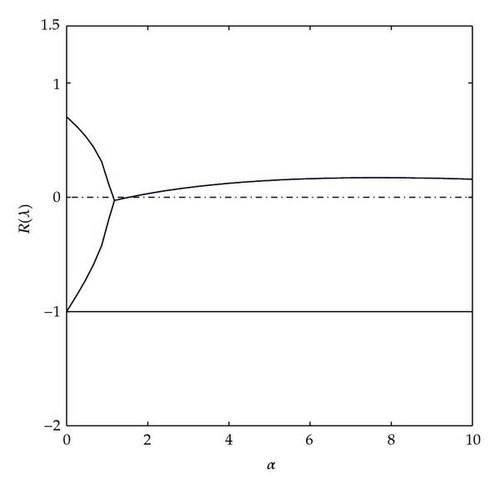
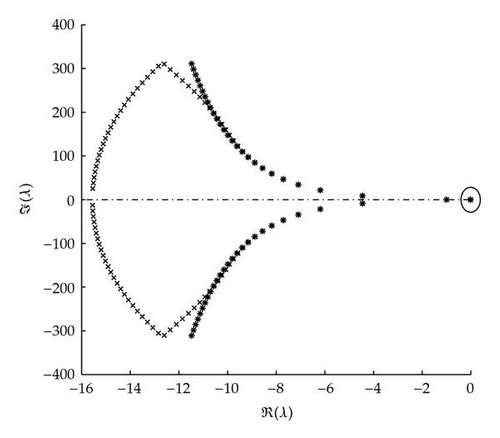
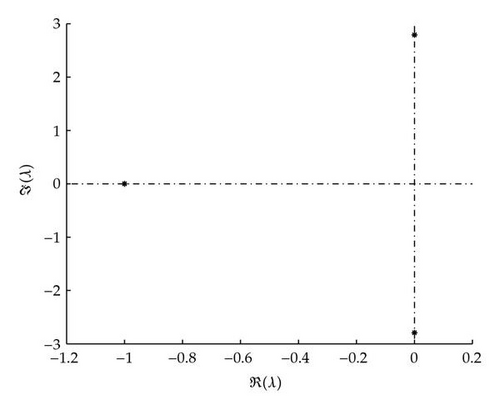
Finally fix all parameters as before and vary both τ and α. In Figure 3, we plot the Hopf bifurcation diagram in α and τ parameter space. The curve at the left upper corner is τ = τc. For any pair (α, τ) below that curve, a coexistence equilibrium E+ exists (i.e., all components are positive). For any pair (α, τ) on the closed curve, there is a Hopf bifurcation. Inside the closed curve, there is a periodic solution surrounding E+. For any (α, τ) outside the closed curve and below τ = τc, the coexistence equilibrium E+ is stable.
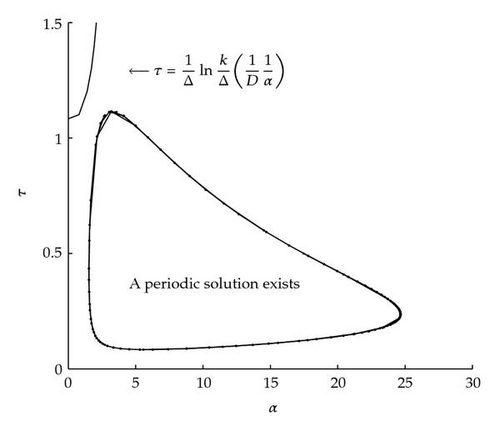
5.2. Simulations Demonstrating Hopf Bifurcations
In this section, we illustrate Theorem 4.9 for system (2.3). Take D = Δ = 1 and let τ vary. We choose parameters α = 100 and k = 100 for Case 1 (see Figures 4–12), and α = 2 and k = 20 for Case 2 (see Figures 13–18).
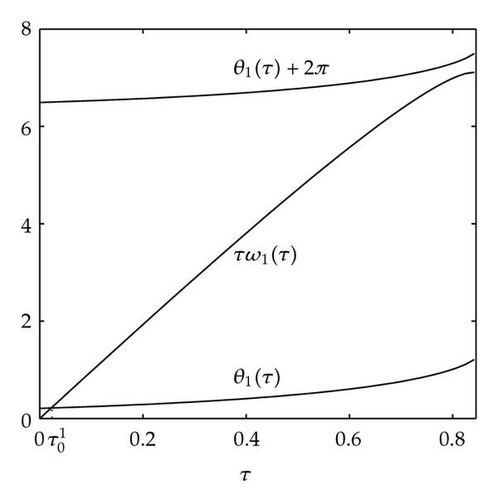
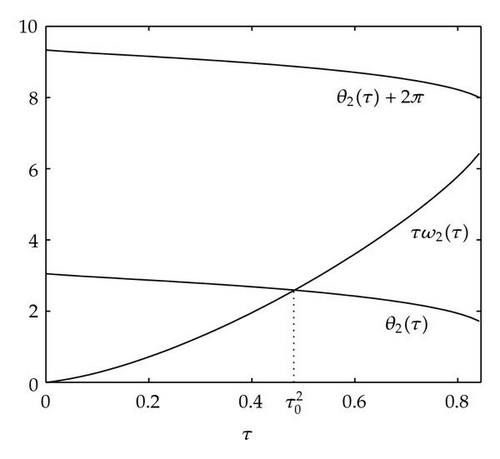
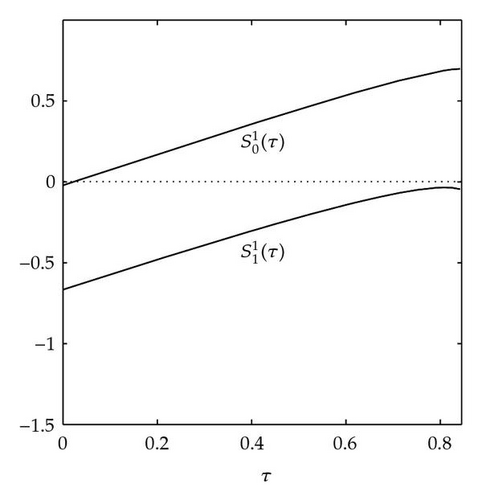
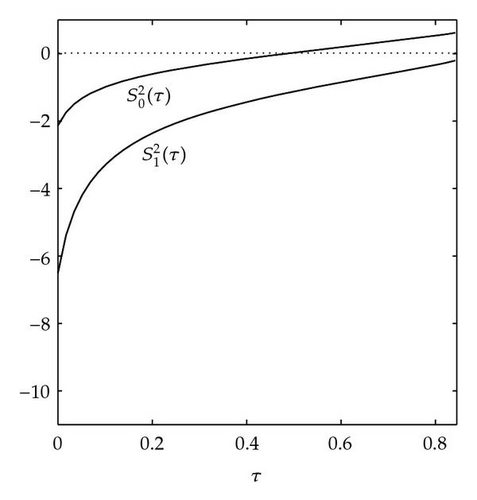






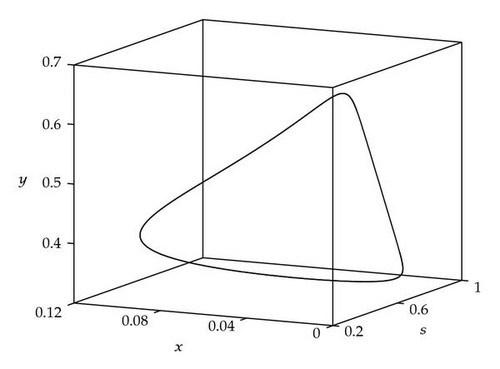



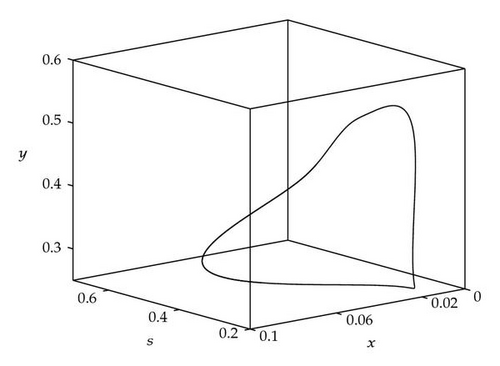



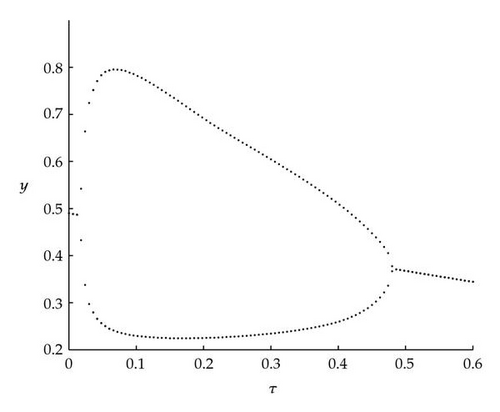
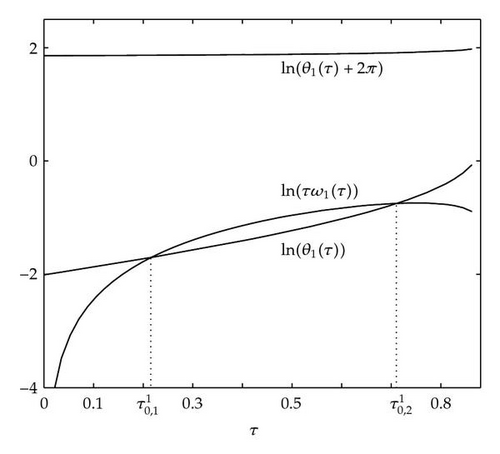
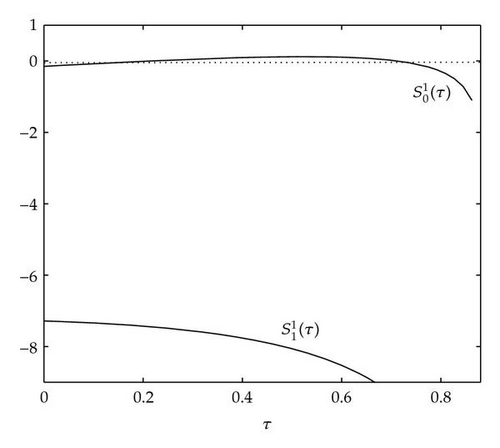






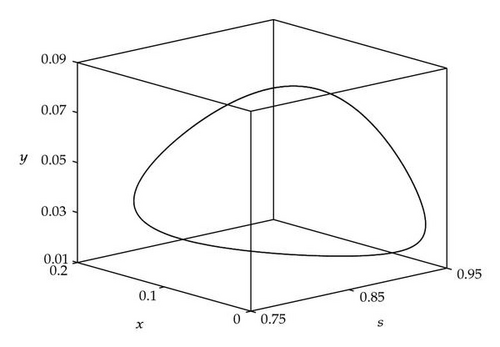



Case 1. Note that I1 is given by (4.22). Since ,
Figure 4 shows that θj(τ) intersects τωj(τ) at some with and . We see that θj(τ) + 2nπ has no intersection with τωj(τ) for n⩾2 and j = 1,2. By Theorem 4.9, (4.4) has two distinct pairs of pure imaginary eigenvalues . Next we need to check if .
As in Beretta and Kuang [13], we can define
From Figure 5(a), it is observed that has only one zero at n = 0 with Hence, By Theorem 4.9, system (2.3) undergoes a Hopf bifurcation at . Similarly from Figure 5(b), has only one zero for n = 0 and (2.3) undergoes a Hopf bifurcation at .
Next we used MATLAB to simulate solutions of model (2.3) for several values of τ. For each fixed delay τ, we chose initial data s(t) = s+(τ) − 0.01, x(t) = x+(τ) + 0.01, and y(t) = y+(τ) + 0.001 for t ∈ [−τ, 0]. From Figure 6, we can see that the equilibrium E+ is stable if . As delay τ increases past , where a Hopf bifurcation occurs, a pair of complex eigenvalues of (4.4) enters the right-half plane. The equilibrium E+ loses its stability and a periodic solution bifurcates from E+ (see Figures 7 and 8). As we increase the delay further to , the periodic solution still exists and remains stable (see Figures 9 and 10). However, as the delay τ increases further, past , the stable periodic solution disappears in a second Hopf bifurcation, and E+ regains stability (see Figure 11). We provide a bifurcation diagram illustrating the change in dynamics as τ varies (see Figure 12). For any , there is an orbitally asymptotically stable periodic solution.
Case 2. Take k = 20 and α = 2. For such parameters, I2 ≈ [0,0.85]. By Theorem 4.9, ω1(τ) is positive and θ1(τ) satisfies (4.56) for j = 1 and τ ∈ I2. Figure 13 shows that θ1(τ) intersects τω1(τ) twice. To distinguish these intersections, denote them as and . On the other hand, θ1(τ) + 2π has no intersection with τω1(τ).
From Figure 14,
Acknowledgment
This research is partially supported by NSERC.
Appendix
Preliminary Results
To establish the existence of periodic solutions in autonomous delay differential equations, one of the simplest ways is through Hopf Bifurcation. Below is a general Hopf Bifurcation theorem for delay differential equations due to De Oliveira [14]. Before stating the theorem we require some notation.
Consider a one parameter family of neutral delay differential equations:
-
S1 There exist constants a > 0, b > 0 such that, for all complex values λ such that |Reλ | < a and all α ∈ ℝ, the following inequalities hold:
(A.5) -
S2 The characteristic equation det Δ(α, λ) = 0 has, for α = α0, a simple purely imaginary root λ0 = iv0, v0 > 0, and no root of det Δ(α0, λ) = 0, other than ±iv0, is an integral multiple of λ0.
-
S3 Re(∂λ(α0)/∂α) ≠ 0.
Now we are ready to state the Hopf bifurcation theorem for (A.1).
Theorem A.1 (Hopf bifurcation theorem, see Kuang [10, page 60]). In (A.1), assume that (S1)–(S3) hold. Then there is an ϵ > 0 such that, for a ∈ ℝ, |a | ⩽ ϵ, there are functions α(a) ∈ ℝ, ω(a) ∈ ℝ, α(0) = α0, ω(0) = 2π/v0, such that (A.1) has an ω(α)-periodic solution x*(a)(t), that is continuously differentiable in t, and a with x*(0) = 0. Furthermore, for |α − αo | < ϵ, |ω − (2π/v0)| < ϵ, every ω-periodic solution x(t) of (A.1) with |x(t)| < ϵ must be of this type, except for a translation in phase; that is, there exists a ∈ (−ϵ, ϵ) and b ∈ ℝ such that x(t) = x*(a)(t + b) for all t ∈ ℝ.
The following lemma is usually called the Fluctuation Lemma. For a proof, see Hirsh et al. [15].
Lemma A.2. Let f : ℝ+ → ℝ be a differentiable function. If lim inf t→∞f(t) < lim sup t→∞f(t), then there are sequences tm↑∞ and sm↑∞ such that for all m
The proof of the following useful lemma can be found in [16].
Theorem A.3. Let a ∈ (−∞, ∞) and f : [a, ∞) → ℝ be a differentiable function. If lim t→∞f(t) exists (finite) and the derivative function is uniformly continuous on (a, ∞), then .




